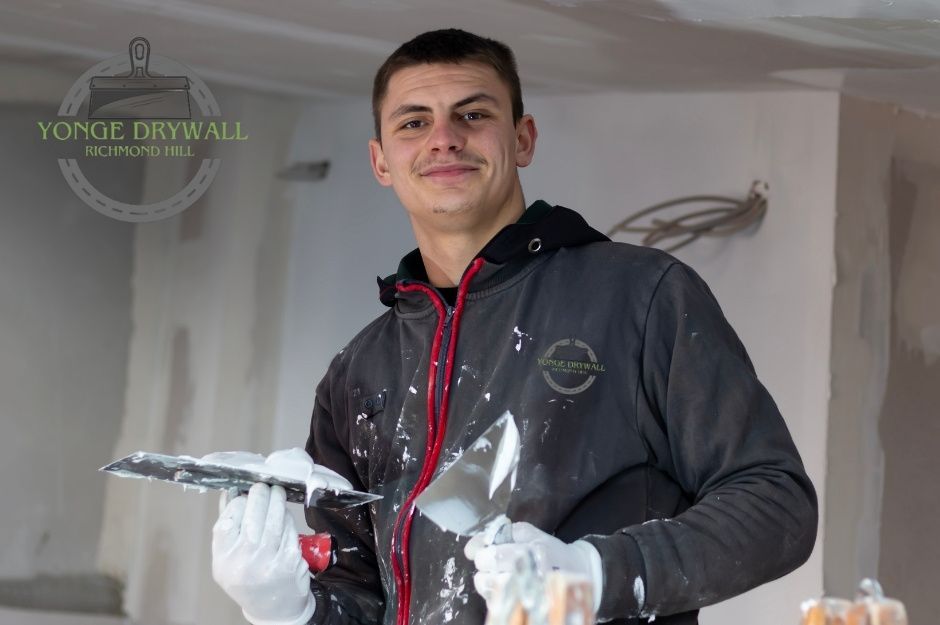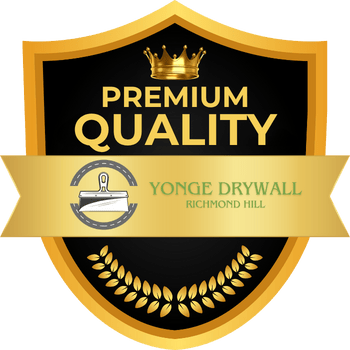Drywall Repair Uxbridge
Top-Quality Drywall Repair Service Company in Uxbridge, Ontario

Drywall damage in your Uxbridge home can range from minor scuffs to major water damage that compromises the structural integrity of your walls and ceilings. Professional drywall services at Yonge Drywall Richmond Hill in Uxbridge encompass comprehensive repair solutions including hole patching, water damage restoration, popcorn ceiling removal, and complete installation of new drywall systems.
Given Uxbridge's location in the Regional Municipality of Durham and its humid continental climate, homes in this south-central Ontario township face unique challenges including temperature fluctuations and moisture issues that can accelerate drywall deterioration. Whether you're dealing with unsightly holes, persistent ceiling cracks, or outdated popcorn textures, these issues require prompt attention to maintain your property's value and appearance.
These specialized contractors handle everything from minor cosmetic fixes to extensive renovations that require soundproof installation and custom texturing work. Serving the main Uxbridge community as well as surrounding settlements like Goodwood, Leaskdale, Sandford, Udora, and Zephyr, local contractors understand the specific construction methods found in homes dating back to the township's 1850 incorporation.
Choosing the right drywall company for your Uxbridge property involves understanding the full scope of services available and the expertise required for different types of damage. Professional teams bring specialized knowledge in mudding, taping, and finishing techniques that ensure seamless repairs and long-lasting results.

Yonge Drywall Richmond Hill (HP)

Drywall Repair Services in Uxbridge
Professional drywall repair in Uxbridge addresses common issues like ceiling cracks, popcorn ceiling removal, hole patching, and water damage restoration. Local specialists serving the Durham Region understand the unique challenges faced by homes in Uxbridge's historic Quaker Hill area, where buildings like the 1820 Friends Meeting House require careful restoration work, as well as newer suburban developments throughout the township. Advanced techniques restore walls and ceilings to their original condition.
Ceiling Crack and Stress Crack Repair
Ceiling cracks develop from structural settling, temperature changes, and moisture fluctuations. In Uxbridge, homes built during different eras—from the original 1806 Quaker settlements to properties constructed after the 1974 municipal amalgamation of Uxbridge Township, Town of Uxbridge, and Scott Township—each present distinct structural characteristics that influence crack patterns. Small hairline cracks typically indicate normal house movement, while larger cracks may signal structural issues.
Professional ceiling repair involves cleaning the crack, applying mesh tape, and filling with joint compound. Multiple coats ensure a smooth finish that blends seamlessly with surrounding areas.
Common crack types include:
- Hairline stress cracks from settling
- Corner cracks at wall intersections
- Sagging areas from moisture exposure
- Impact damage from accidents
Proper crack repair prevents future expansion and maintains structural integrity. Quality repairs eliminate visible seams and create uniform surface texture across the entire ceiling area.
Popcorn Ceiling and Stucco Ceiling Repair
Popcorn ceiling repair addresses damaged sections without full removal. Professionals match existing texture patterns and apply new material to blend with surrounding areas seamlessly.
Water damage often affects textured ceiling repair requirements. Stained or crumbling sections require complete removal before applying fresh texture coatings.
Repair process includes:
- Damage assessment and preparation
- Texture removal in affected areas
- Surface priming and sealing
- New texture application and blending
Textured ceiling repair maintains the original appearance while addressing underlying damage. Professional application ensures consistent texture patterns that match existing surfaces throughout the room.
Hole Patching and Wall Damage Restoration
Wall repair specialists handle holes from nail pops, doorknob impacts, and accidental damage. Small holes require simple patching, while larger openings need mesh backing and multiple compound applications.
Professional hole patching creates invisible repairs that withstand normal wear. Proper techniques prevent future cracking around patch areas and ensure long-lasting results.
Repair methods vary by size:
- Small holes: Self-adhesive patches
- Medium holes: Mesh tape backing
- Large holes: Drywall replacement sections
- Deep gouges: Multiple compound layers
Quality patches maintain wall strength and provide smooth surfaces for wall painting. Skilled technicians match existing wall texture and prepare surfaces for final finishing touches.
Water Damage and Leak Solutions
Water damage requires immediate attention to prevent mold growth and structural deterioration. Professional assessment determines repair scope and identifies underlying moisture sources causing the damage. Uxbridge homeowners, particularly those near the township's numerous waterways and rural areas, should be vigilant about water damage—the 30-bed Uxbridge Cottage Hospital opened in 1958 (expanded in 2022) can provide referrals to indoor air quality specialists if mold-related health concerns arise.
Ceiling damage from leaks often extends beyond visible stains. Hidden moisture weakens drywall structure and requires complete section replacement rather than surface repairs alone.
Water damage repair steps:
- Moisture source elimination
- Damaged material removal
- Structural drying and treatment
- New drywall installation
- Primer and finish application
Drywall ceiling repair after water exposure includes insulation replacement and vapor barrier installation. Professional restoration prevents future moisture problems and ensures proper ventilation in affected areas.
Popcorn Ceiling Removal and Refinishing
Popcorn ceiling removal transforms outdated textured ceilings into smooth, modern surfaces through specialized techniques and equipment. The complete process includes stucco removal, surface preparation, texture matching, and professional finishing work. Many Uxbridge homes built during the 1960s-1980s boom period, when the Toronto and Nipissing Railway connection made the township accessible to Greater Toronto Area commuters, feature popcorn ceilings that are now prime candidates for modernization.
Professional Popcorn Ceiling Removal Process
Professional popcorn ceiling removal experts use specialized techniques to safely eliminate textured surfaces. The process begins with thorough preparation including plastic sheeting to protect floors and furniture.
Water misting softens the popcorn texture before scraping begins. This method reduces dust and makes removal more efficient. Contractors use wide putty knives and scrapers designed specifically for ceiling work.
Safety considerations include:
- Asbestos testing for homes built before 1980
- Proper ventilation during removal
- Lead paint precautions when necessary
After scraping, the ceiling surface requires inspection for damage. Small imperfections get filled with joint compound. The surface then receives sanding to create a smooth base for finishing.
Flattening Stucco and Textured Ceilings
Stucco removal requires different techniques than standard popcorn ceilings. Heavy stucco textures need aggressive scraping methods and specialized tools. Some stucco ceilings require multiple passes to achieve complete removal.
Dustless sanding equipment minimizes cleanup and improves air quality during the process. These systems capture debris at the source rather than allowing it to spread throughout your home.
Stucco removal challenges:
- Thicker texture layers
- Stronger adhesion to drywall
- Potential surface damage during removal
Professional contractors assess each ceiling individually. Some heavily textured surfaces benefit from skim coating rather than complete removal. This approach involves applying thin layers of joint compound over existing texture.
Texture Matching and Retexturing for Seamless Results
Texture matching ensures consistent appearance when only portions of your ceiling require work. Professional contractors can replicate various ceiling textures including orange peel, knockdown, and smooth finishes.
Retexturing involves applying new texture patterns to create uniform surfaces. This process requires skill to achieve consistent results across large ceiling areas. Different tools create specific texture patterns.
Common retexturing options:
- Orange peel texture - Light, consistent bumps
- Knockdown texture - Flattened peaks and valleys
- Skip trowel - Irregular, hand-applied patterns
- Smooth finish - Completely flat surface
Sample patches help you choose the desired texture before full application. Contractors often create test areas in inconspicuous locations to ensure satisfaction with the final appearance.
Ceiling Painting and Final Finishes
Ceiling painting completes the transformation from textured to smooth surfaces. Proper primer application ensures even paint coverage and prevents stains from bleeding through. High-quality primer also improves paint adhesion on newly textured surfaces.
Professional painters use specific techniques for ceiling work. Roller selection affects the final appearance, with different nap lengths suited to various textures. Spray application provides the most uniform coverage on large ceiling areas.
Paint selection considerations:
- Flat paint hides minor imperfections
- Eggshell finish offers easier cleaning
- Color choice affects room brightness
Multiple coats ensure complete coverage and rich color depth. Professional contractors maintain wet edges to prevent lap marks. The final result provides a clean, modern ceiling that enhances your room's overall appearance.
Drywall Installation and Finishing Expertise
Professional drywall installation requires precise measurement, proper fastening techniques, and seamless integration with existing structures. Quality finishing involves expert mudding, taping of drywall seams, and texture matching to create uniform wall and ceiling surfaces. Contractors serving Uxbridge and surrounding communities like Altona, Coppin's Corners, Glasgow, Glen Major, and Roseville bring expertise in working with both heritage properties and modern construction.
Drywall Installation and Replacing Ceiling Panels
Proper drywall installation begins with accurate measurements and selecting the correct panel thickness for your specific application. Standard 1/2-inch panels work well for most walls, while 5/8-inch panels provide better fire resistance and sound control.
When replacing ceiling panels, contractors secure new drywall to ceiling joists using appropriate fasteners spaced 8 inches apart along edges and 12 inches in the field. This spacing prevents sagging and ensures long-term stability.
Key Installation Steps:
- Measure and cut panels to fit room dimensions
- Mark stud and joist locations
- Install panels with proper fastener spacing
- Leave 1/4-inch gaps at floor and ceiling joints
Professional installers cut precise openings for electrical outlets, switches, and fixtures before mounting panels. They also ensure proper alignment between adjacent panels to minimize visible seams.
Soundproof Drywall Solutions
Soundproof drywall installation involves specialized materials and techniques that reduce noise transmission between rooms. This service is particularly valuable for Uxbridge residents living near major employers like Pine Valley Packaging, Koch-Glitsch Canada, or Hela Canada, as well as those in densely populated suburban developments who desire quieter home environments. Mass-loaded vinyl barriers and resilient channels create effective sound isolation systems.
Double-layer drywall installation significantly improves acoustic performance. The first layer attaches directly to studs, while the second layer offsets seams and adds mass to block sound waves.
Soundproofing Materials:
- Mass-loaded vinyl: Dense barrier material
- Resilient channels: Metal strips that decouple drywall from studs
- Acoustic caulk: Seals gaps around perimeter
- Fiberglass insulation: Absorbs sound within wall cavities
Sound-rated assemblies require careful attention to air gaps and penetrations. Even small openings can compromise acoustic performance, so contractors seal all electrical boxes and pipe penetrations with acoustic caulk.
Drywall Mudding and Taping
Drywall taping covers joints between panels using paper or fiberglass mesh tape embedded in joint compound. The process requires three coats: embedding, filling, and finishing coats applied in progressively wider passes.
Professional mudding creates smooth transitions at drywall seams using specialized tools. Taping knives range from 4 inches for embedding tape to 12 inches for final finishing passes.
Mudding Process:
- First coat: Embed tape in thin layer of compound
- Second coat: Apply 8-10 inch wide pass over dried first coat
- Third coat: Feather edges with 12-inch knife for smooth finish
Each coat must dry completely before sanding and applying the next layer. Proper drying prevents cracking and ensures strong adhesion between coats.
Corner beads protect outside corners from damage while providing straight, clean edges. Inside corners use folded paper tape for flexible joint coverage.
Texturing for Walls and Ceilings
Wall and ceiling textures add visual interest while helping conceal minor surface imperfections. Common texture types include orange peel, knockdown, and skip trowel finishes applied over primed drywall surfaces.
Texture matching requires skill to blend new areas with existing finishes. Contractors analyze existing texture patterns, density, and application techniques to achieve seamless repairs.
Popular Texture Types:
- Orange peel: Light, consistent spray texture
- Knockdown: Flattened spray texture with subtle variations
- Skip trowel: Hand-applied texture with irregular patterns
Professional texturing uses spray equipment or hand tools depending on the desired finish. Spray textures provide consistent coverage for large areas, while hand textures create unique artistic effects.
Proper primer application before texturing ensures even absorption and color consistency. This step prevents texture materials from being absorbed unevenly into the drywall surface.
Why Choose a Professional Drywall Company in Uxbridge
Professional drywall companies in Uxbridge bring specialized expertise, advanced equipment, and local knowledge to ensure your project meets high standards. With the township's diverse housing stock—from 19th-century heritage buildings in areas like Quaker Village and Siloam to contemporary homes in newer subdivisions—experienced local contractors understand the specific requirements of each property type. They provide comprehensive assessments, maintain clean work environments, and deliver reliable results backed by experience.
Benefits of Expert Assessment and Free Estimates
Professional drywall contractors provide thorough evaluations of your repair or installation needs before starting work. They identify underlying issues like structural problems or moisture damage that DIY approaches might miss.
Expert assessments help determine the most cost-effective solutions for your specific situation. A professional can distinguish between simple patch repairs and more complex issues requiring full panel replacement.
Free estimates from qualified contractors include:
- Detailed scope of work breakdown
- Material specifications and quantities
- Labor time requirements
- Timeline for project completion
Licensed contractors understand local building codes and permit requirements in Uxbridge. They ensure your drywall work meets Durham Region municipal standards and passes inspections when required, navigating the regulatory framework established since Uxbridge joined the Regional Municipality of Durham in 1974.
Professional evaluations save money by preventing costly mistakes and identifying the root causes of damage.
Ensuring Cleanliness with Dustless Sanding Equipment
Modern drywall companies use dustless sanding equipment to minimize mess during finishing work. This technology captures dust particles at the source, preventing them from spreading throughout your home.
Traditional sanding creates fine dust that settles on furniture, floors, and ventilation systems. Dustless sanding equipment eliminates up to 95% of airborne particles during the smoothing process.
The equipment includes:
- High-powered vacuum attachments
- HEPA filtration systems
- Sealed collection containers
This approach protects your belongings and reduces cleanup time significantly. You won't need to cover furniture extensively or deal with dust settling for days after completion.
Dustless systems also improve air quality during the project, making the work environment safer for both workers and residents.
Licensed, Experienced, and Local Teams
Professional drywall companies in Uxbridge employ licensed technicians with years of hands-on experience. These teams understand the specific challenges of working in local homes throughout the township—from Forsythe Glenn to Quaker Village—including older construction methods influenced by the area's Quaker settlers who arrived from Catawissa, Pennsylvania in 1806, as well as climate-related issues common to the Durham Region.
Licensed contractors provide:
- Insurance coverage for liability protection
- Warranty guarantees on completed work
- Bonding for financial security
- Compliance with provincial regulations
Local teams respond quickly to service calls and understand Uxbridge's housing characteristics. They're familiar with common drywall problems in the area and have established relationships with local suppliers. Many maintain service routes accessible via Durham Region Transit Route 950, ensuring reliable arrival times for scheduled appointments throughout communities including the former Scott Township settlements of Leaskdale and Zephyr.
Experienced professionals complete projects efficiently while maintaining quality standards. They handle unexpected complications without delays and use proven techniques for lasting repairs.
Working with local contractors supports the community economy and ensures ongoing availability for future maintenance needs. As Uxbridge continues growing as a suburban hub in northern Durham Region—with many residents commuting to employment centers in York Region and beyond—reliable local service providers become increasingly valuable for maintaining your home investment.
